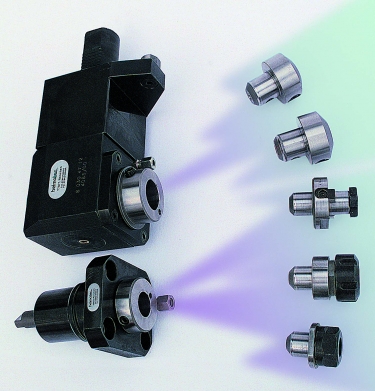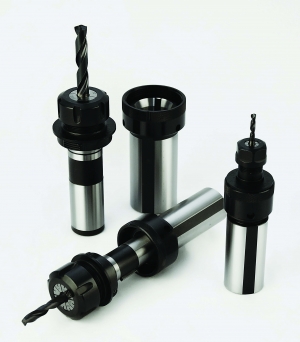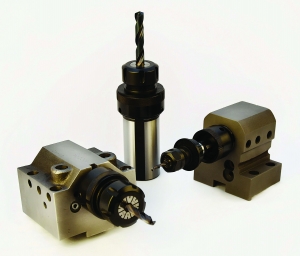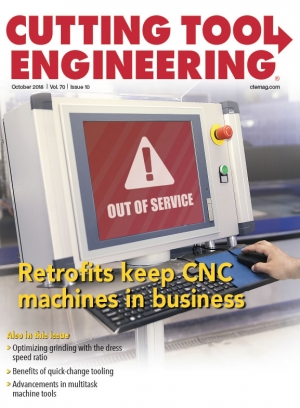Whether working with static or live tools, anytime you change a tool, you’re not making parts. That makes a quick-change tooling system—in which the changeover time is reduced to mere seconds—worth consideration.
“Live tools especially are not easy to take in and out of a machine,” said Preben Hansen, president of Heimatec Inc., Prospect Heights, Illinois. “When you’re changing cutting tools, it’s nice to have a quick-change system where you can preset the inserts outside of the machine so you know exactly the tool length going in.”

Heimatec’s HT Quick Change tooling system allows live tools and angle heads to remain permanently mounted in the machine. Image courtesy of Heimatec
Heimatec makes the HT Quick Change tooling system for use with its line of live tools and angle heads, allowing them to remain permanently mounted in the machine. A removable insert holding the cutting tool easily locks into the live tool. Inserts are available for various components, such as ER collets, side lock holders and facemill adapters.
“To change the tool, a single clamping taper screw is loosened up on the live tool cylinder guide; the insert comes out and you put a different one in,” said Hansen, who added that for a minimal cost, a machinist can have another insert sitting on the side ready to go. “When a part’s being changed, they just put in the new insert. The changeover is very quick versus taking the live tool out of the machine and having to reset everything.”
Quick-Change Applications
There are two basic uses for a quick-change tooling system: production and running a family of parts.
“A lot of production shops know a drill will last for, say, a thousand pieces before it dulls and then they have to replace it,” Hansen said. “With a quick-change system, you can have a set of cutting tools preset to the same dimension, ready to go. So you just take out that tool and put another one in—and there’s no downtime involved.”
At the same time, Jared McKown, operations manager at T.M. Smith Tool International Corp., Mount Clemens, Michigan, sees a huge benefit for those who make many different parts and do changeovers frequently, even multiple times a day.
“Say, for instance, you’re running several related parts where one needs a ½" hole, the other one needs a 3⁄8" hole,” McKown said. “You’re able to change between those two tools much quicker than if you actually had to take out the holder for the ½" and then put in and set-screw down a new holder for the 3⁄8".”
T.M. Smith offers a couple of quick-change systems. These include an extended range of ball-drive, quick-change tap holders and tap adapters, from very small taps up to 2" taps, with different types of coolant-through designs and collet-style adapters.
In addition to its tap holders, T.M. Smith makes a quick-change drilling system, which was originally designed to fit only spindles specific to these holders. Now, with the help of quick-change sleeve adapters, any lathe with a straight-bore lathe block can become quick-change tooling.
The drilling system uses two styles of connectors: the Ball-Lock and Smith-Lock. Both can be used on CNC lathes, screw machines and automotive (straight bore) and Tru-Taper spindles. The holder consists of two parts: an over-spindle adapter (OSA), either in the Ball-Lock or Smith-Lock style, and the matching toolholder.


Quick-change systems from T.M. Smith Tool benefit those who make many different parts and do changeovers frequently. Images courtesy of T.M. Smith Tool International
The Smith-Lock design has OD threads on the toolholder and ID threads on the OSA, and they mate using two threaded tabs 180° apart, McKown said. “As you’re rotating the shell of the OSA one quarter turn, the OD threads and ID threads engage, which then locks the holder down.”
The T.M. Smith Ball-Lock system is also a two-piece system with ball bearings around the ID of the OSA.
“When you pull forward on the OSA shell, it releases the ball bearings, allowing them to move slightly inward, and then you’re able to insert the toolholder,” McKown said. “Once you have the holder in the adapter, you release the shell back into its resting position, which locks the balls onto the taper of the holder.”
In addition to switching drill sizes, the T.M. Smith quick-change drilling system gives the ability to switch between drilling and tapping with the help of conversion nuts.
Quick-Change Challenges
McKown explained that shops must take both the benefits and disadvantages into consideration before investing in a quick-change tool system. Because there are costs to implement any type of system, benefits have to outweigh those costs. “A lot of times, that’s based on the job itself—how many times you’re changing a tool in a specific period and how long it takes to change a tool,” McKown said.
Two considerations are space in the machine and part and fixture geometry. According to McKown, someone changing a tool only once a shift might not be reducing much downtime but may be eliminating difficulty if changing tools is easier because of the design of the machine. Regarding space, small machines can complicate options for quick-change systems.
“For example, you might not be able to reach both hands into the machine to operate our Ball-Lock system, but you may be able to use our Smith-Lock design, where you can change the tool with one hand by just turning the shell a quarter turn, then pulling out the toolholder or putting another one in,” McKown said.
An important consideration with a quick-change system is the potential for less rigidity, which could lead to poor surface quality and increased tool wear.
“I believe that a quick-change system, because it’s two pieces, is not optimum for all applications,” Hansen said. “The repeatability and accuracy are always going to be there, but there are some applications where a quick change would not be as rigid as a standard toolholder. It’s because you’ve added in a piece and you’re extending it off the nose, so the cutting tool is further away from the bearings of the live tool.”
In spite of these considerations, Hansen and McKown both find that today’s customers want flexibility and the ability to easily change tools.
As an example, McKown pointed to a customer that specializes in the production of internally threaded fasteners. The company implemented the Ball-Lock quick-change system on 25 screw machines and saw a decrease in tool-change time of 40 minutes per machine per shift. “The quick-change system allows the operator to change tools with a ready-to-go preset toolholder with very little ‘door-open’ time,” McKown said. “The customer mostly uses quick-change drill holders but through the use of Ball-Lock quick-change conversion nuts has implemented the system for tapping and reaming operations as well.”
Related Glossary Terms
- computer numerical control ( CNC)
computer numerical control ( CNC)
Microprocessor-based controller dedicated to a machine tool that permits the creation or modification of parts. Programmed numerical control activates the machine’s servos and spindle drives and controls the various machining operations. See DNC, direct numerical control; NC, numerical control.
- facemill
facemill
Milling cutter for cutting flat surfaces.
- family of parts
family of parts
Parts grouped by shape and size for efficient manufacturing.
- fixture
fixture
Device, often made in-house, that holds a specific workpiece. See jig; modular fixturing.
- inner diameter ( ID)
inner diameter ( ID)
Dimension that defines the inside diameter of a cavity or hole. See OD, outer diameter.
- lathe
lathe
Turning machine capable of sawing, milling, grinding, gear-cutting, drilling, reaming, boring, threading, facing, chamfering, grooving, knurling, spinning, parting, necking, taper-cutting, and cam- and eccentric-cutting, as well as step- and straight-turning. Comes in a variety of forms, ranging from manual to semiautomatic to fully automatic, with major types being engine lathes, turning and contouring lathes, turret lathes and numerical-control lathes. The engine lathe consists of a headstock and spindle, tailstock, bed, carriage (complete with apron) and cross slides. Features include gear- (speed) and feed-selector levers, toolpost, compound rest, lead screw and reversing lead screw, threading dial and rapid-traverse lever. Special lathe types include through-the-spindle, camshaft and crankshaft, brake drum and rotor, spinning and gun-barrel machines. Toolroom and bench lathes are used for precision work; the former for tool-and-die work and similar tasks, the latter for small workpieces (instruments, watches), normally without a power feed. Models are typically designated according to their “swing,” or the largest-diameter workpiece that can be rotated; bed length, or the distance between centers; and horsepower generated. See turning machine.
- outer diameter ( OD)
outer diameter ( OD)
Dimension that defines the exterior diameter of a cylindrical or round part. See ID, inner diameter.
- sawing machine ( saw)
sawing machine ( saw)
Machine designed to use a serrated-tooth blade to cut metal or other material. Comes in a wide variety of styles but takes one of four basic forms: hacksaw (a simple, rugged machine that uses a reciprocating motion to part metal or other material); cold or circular saw (powers a circular blade that cuts structural materials); bandsaw (runs an endless band; the two basic types are cutoff and contour band machines, which cut intricate contours and shapes); and abrasive cutoff saw (similar in appearance to the cold saw, but uses an abrasive disc that rotates at high speeds rather than a blade with serrated teeth).
- tap
tap
Cylindrical tool that cuts internal threads and has flutes to remove chips and carry tapping fluid to the point of cut. Normally used on a drill press or tapping machine but also may be operated manually. See tapping.
- tapping
tapping
Machining operation in which a tap, with teeth on its periphery, cuts internal threads in a predrilled hole having a smaller diameter than the tap diameter. Threads are formed by a combined rotary and axial-relative motion between tap and workpiece. See tap.
- toolholder
toolholder
Secures a cutting tool during a machining operation. Basic types include block, cartridge, chuck, collet, fixed, modular, quick-change and rotating.
- turning
turning
Workpiece is held in a chuck, mounted on a face plate or secured between centers and rotated while a cutting tool, normally a single-point tool, is fed into it along its periphery or across its end or face. Takes the form of straight turning (cutting along the periphery of the workpiece); taper turning (creating a taper); step turning (turning different-size diameters on the same work); chamfering (beveling an edge or shoulder); facing (cutting on an end); turning threads (usually external but can be internal); roughing (high-volume metal removal); and finishing (final light cuts). Performed on lathes, turning centers, chucking machines, automatic screw machines and similar machines.
Contributors
Heimatec Inc.
847-749-0633
usa.heimatecinc.com
T.M. Smith Tool
International Corp.
800-521-4894
www.tmsmith.com








